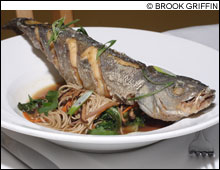 There are at least three kinds of lineage invoked here. One is that chef-owner Jeremy Sewall is a descendent of the Salem judge who wrote in his diary about his enjoyment of memorable meals and treats, such as a 1697 cup of chocolate with the lieutenant governor, and whose son was a founder of Brookline. Another is that Sewall used to work at Great Bay (his wife and co-owner, Lisa, was the pastry chef at L’Espalier), and his seafood appetizers and entrées are impeccable. A third lineage might be the space, which is still built around the wood-fired oven of the lamented Zaatar’s Oven and the lamented (by its second year) Lucy’s. Speaking as a descendent of peddlers and scissor grinders myself, I’m not a big believer in lineage, but Sewall’s food shows that he knows what do with his three inheritances.
There are at least three kinds of lineage invoked here. One is that chef-owner Jeremy Sewall is a descendent of the Salem judge who wrote in his diary about his enjoyment of memorable meals and treats, such as a 1697 cup of chocolate with the lieutenant governor, and whose son was a founder of Brookline. Another is that Sewall used to work at Great Bay (his wife and co-owner, Lisa, was the pastry chef at L’Espalier), and his seafood appetizers and entrées are impeccable. A third lineage might be the space, which is still built around the wood-fired oven of the lamented Zaatar’s Oven and the lamented (by its second year) Lucy’s. Speaking as a descendent of peddlers and scissor grinders myself, I’m not a big believer in lineage, but Sewall’s food shows that he knows what do with his three inheritances.
Lineage the restaurant does all three of them proud. It’s a rather fancy and formal restaurant for the suburbs, more like Le Soir or Lumière than anything else outside Boston or Cambridge, but the food is consistently good, and even the expensive wine list has its moments at the low end.

Food starts with soft, warm, eggy rolls with rough salt on the outside. Unsalted butter goes really well with these rolls, all but insinuating that the poured extra-virgin olive oil of the 1990s need never have happened. For real appetizers, go right to the wood grill and get something like the roasted clams ($12) or the white-potato-mushroom/parmesan/white-truffle-oil pizza ($9). The latter is a thin-crust masterpiece, with the potatoes adding another kind of crunch, and the sliced baby bella mushrooms providing a focus for the musky truffle aroma, so pronounced that even a truffle-insensitive nose such as mine could pick up some of the sharp sandlewood smell. The clams are only five littlenecks, mounted on salt on a long plate, but the filling of buttered crumbs, herbs, and bits of pancetta (perhaps) is almost a recreation of the original idea of oysters Rockefeller.
My favorite appetizer on two visits — the menu changes daily — was a single crab cake ($14). That’s a high price for a crab cake, but this was close to ultimate: crusty; full of crabmeat, with flecks of cilantro; and served with a salsa of mango in tiny cubes. A salad of field greens ($8) was underdressed and mostly baby spinach and almonds on one visit, perfectly dressed and leaning to frisee and bitter greens the second time. Beet “raviolis” ($11) were three fanciful sandwiches of thin-sliced beet and goat cheese, with a nice crouton topped with some salad and shredded beets. It’s something for the vegetarians, but I’d advise them to stick with the wood-grilled pizza.
Regarding the entrées, it’s important to get something with grits, which this kitchen makes into a rich, creamy wonder. (You may have to order them as a side dish, at $6.) Try the pork porterhouse ($22), which is almost two inches thick, yet juicy and delectable, and is served with some well-sautéed Swiss chard as a foil for the grits. But we had even richer, custard-like yellow polenta under osso bucco ($22), classically served as two meaty veal shanks — could have been braised a little longer — with a tiny marrow spoon. Stewed carrots and parsnips actually tasted as though they had been cooked with the meat.
The underlayment for a special on fluke ($27), which is usually a summer flounder in these parts, was white beans and prosciutto. The fish, from wherever, was superbly fresh and cut from a large fluke, the better to roast and get a little crust. Trout ($22) was almost as rich as Arctic char, and the crunchy basis of couscous and underdone green beans was delightful. The weakest entrée — though it was still fine eating — was the “oak-roasted” chicken ($18), and all it really needed was grits or polenta instead of sliced fingerling potatoes. The chicken had a wonderful crust from the high-temperature oven, but it was a little underseasoned, although I liked the grilled onions and sautéed greens.
The wine list is very good and gets expensive, although fair relative to retail prices. We resorted to a bottle of bubbly, Mumm Napa Prestige ($32), at a bit less than double retail, and it was very good with this food, with an apple-y chardonnay nose. The house wines were a Nicholas Potel 2003 Bourgogne rouge “Cuvée Grand Potel” ($10/glass; $40/bottle) and a Brogna “Gran Piero” Gavi 2004 ($10/$38). The latter got all the fruit and spice of modern winemaking grafted onto the mineral backbone of this ancient white grape from Italy. The former was a light, dry, nicely made and blended red Burgundy — what used to be priced as a food wine, and it still works that way. Tea ($4.25) is served loose-leaf in an Asian cast-iron pot. Decaf ($3.25) was some of the best I’ve had in years.